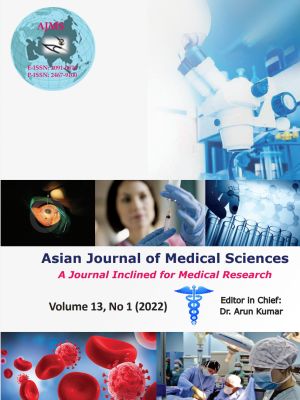Comparative assessment of umbilical cord blood with peripheral venous blood using hematological scoring system as an early predictive screening method for the detection of early-onset neonatal sepsis in the tertiary care center of Central India
Keywords:
Haematological scoring system, Neonatal sepsis, Umbilical cord bloodAbstract
Background: Sepsis is one of the major causes of neonatal morbidity and mortality. Early recognition and diagnosis of early-onset neonatal sepsis (EONS) is difficult because of the variable and non-specific clinical presentation of this condition. Hence, there is a need for early predictive screening method for EONS.
Aims and Objectives: To compare the umbilical cord blood Haematological Scoring System (HSS) with peripheral venous blood as an early predictive screening method for detection of EONS.
Materials and Methods: 100 inborn neonates with two or more risk factors for EONS, chosen by sequential sampling method were included in this prospective analytical study. Blood samples were collected from the umbilical cord and peripheral vein analyzed for hematological parameters, sepsis screen, and peripheral smear for HSS of Rodwell et al., send for blood culture. Blood cultures were performed as gold standard for diagnosing neonatal sepsis and sepsis screen was done to corroborate the diagnosis of neonatal sepsis.
Results: Of 100 neonates, 21 belongs to sepsis; 14 to probable sepsis; 65 to no sepsis. HSS in umbilical cord blood (UCB) had Sensitivity-74.28%, Specificity-92.30%, PPV-83.87%, NPV-86.95% and HSS in PVB had Sensitivity-62.85%, Specificity- 87.69%, PPV-75.86%, NPV-81.69%.
Conclusion: HSS score in UCB can be used as a simple, quick, cost-effective, and readily available screening test with decent sensitivity and high specificity, for the detection of EONS.
Downloads
Downloads
Published
How to Cite
Issue
Section
License
Copyright (c) 2021 Asian Journal of Medical Sciences

This work is licensed under a Creative Commons Attribution-NonCommercial 4.0 International License.
Authors who publish with this journal agree to the following terms:
- The journal holds copyright and publishes the work under a Creative Commons CC-BY-NC license that permits use, distribution and reprduction in any medium, provided the original work is properly cited and is not used for commercial purposes. The journal should be recognised as the original publisher of this work.
- Authors are able to enter into separate, additional contractual arrangements for the non-exclusive distribution of the journal's published version of the work (e.g., post it to an institutional repository or publish it in a book), with an acknowledgement of its initial publication in this journal.
- Authors are permitted and encouraged to post their work online (e.g., in institutional repositories or on their website) prior to and during the submission process, as it can lead to productive exchanges, as well as earlier and greater citation of published work (See The Effect of Open Access).




